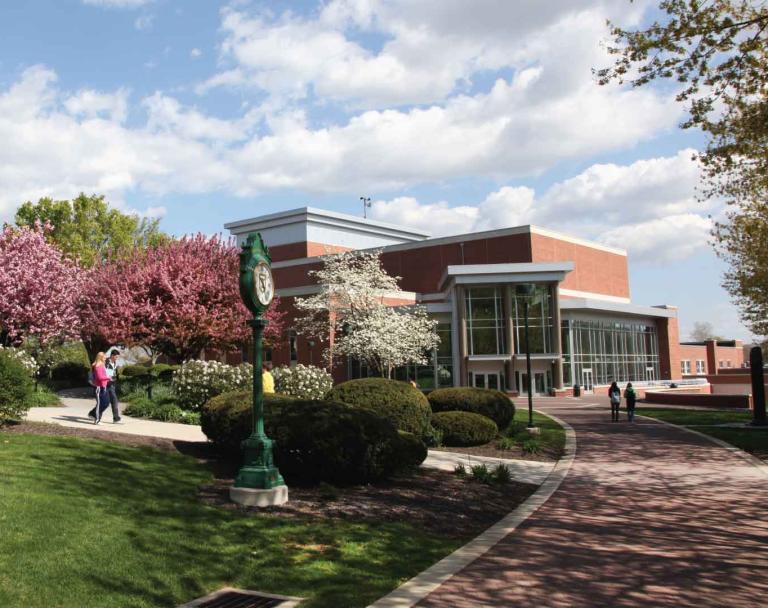Jamie Noerpel

A Monument for Penny Heaven, a Potter's Field in North York
York Mayor Michael Helfrich told Jamie Noerpel ’12 that he had no idea there was a potter's field in North York. When he asked, “Why isn't there a monument there?", she decided to make this happen.
A potter’s field is a paupers’ grave or common grave, which is a place for the burial of unknown, unclaimed or indigent people. Interestingly, the name is said to have a Biblical origin. Potter’s field, also called Akeldama, was bought by the high priests of Jerusalem for the burial of strangers, criminals, and the poor. Prior to its use as a burial ground, it had been a site where potters collected high-quality clay, hence the name.
When Jamie Noerpel ’12 moved into an apartment on Schley Alley in October 2020, she had no idea that York had its own potter’s field. Her kitchen window overlooked Prospect Hill Cemetery–a well-maintained burial ground with many headstones. A keen historian, she enjoyed going for evening walks and reading the gravestones to feel connected to history and the people buried there. Outside her bedroom, on the other side of her apartment, she noticed what looked to be a grassy field. Upon further inspection, she discovered that more than 800 people were buried there in unmarked graves.
Unlike Prospect Hill Cemetery, the people interred in the potter’s field of City Cemetery, also known as Penny Heaven, couldn’t afford a proper burial or were unidentified. People like Margaret Williams, a 5-month-old baby girl who died in 1906. Or Martha Beckman, a 56-year-old woman who spent her last few days during the Great Depression in the county home. Or Clashay Johnson, a 15-month-old boy who passed in 1987 whose name is on the only headstone at the lot.
Noerpel says, “I dove into the research, writing an article for my local history blog called Wandering in York County and filming a video for an online platform I co-founded called Witnessing York.” A professor from Penn State saw the articles and asked her to present on York's City Cemetery at the annual Association of Gravestone Studies. Mayor Helfrich happened to be in the audience, and told her that he had no idea there was a potter's field in North York. He asked, “Why isn't there a monument there?" That set her off on her journey to install one.
Noerpel states, “This initiative goes deeper than a cemetery. It addresses a racial and class division in our community's history. Based on records kept since the 1900s and Find a Grave, we can identify the racial composition of those whose final resting place is in Penny Heaven: 124 white, 91 Black, 49 unidentified, two are described as ‘Spanish,’ and one of mixed race. The identities of hundreds moved in 1897 are unknown.”
According to Noerpel, “This was a time of segregation, so a graveyard with Blacks buried beside whites would have been unheard of.” She asks, “Why is this important?” and says, “Penny Heaven is a symbol of the possibility of unity, if only in death. We’re hoping the monument will change the feel of City Cemetery from a marginalized place of the have-nots into a permanent place of remembering.”
Noerpel found partners willing to help reach a $20,000 goal. The money will go toward a memorial, giving lasting public recognition to those buried in Penny Heaven. She says, “Silbaugh Memorials from Shrewsbury is giving us a large discount on the granite stone. We also discovered local sign companies to make a bronze plaque, describing the history of the cemetery, as well as a laminated sign showing the index of graves.” She adds, “We have a $5,000 maintenance fund for mowing and washing the monument and a few hundred dollars for landscaping. Like the memorial for Farquhar Park, or the new East Philadelphia Street sculpture of William C. Goodridge, or the cleanups at Lebanon Cemetery, we’re hoping this community-driven campaign will strengthen the public’s knowledge of York County’s historic class and racial divides in burial practices – and in life.”
Other organizations and individuals who are working toward the goal include the Friends of York City Cemetery, locals such as Samantha Dorm and Tina Charles from the Friends of Lebanon Cemetery, Dr. Joy Giguere from Penn State York, the Pennsylvania Chapter of the Association of Gravestone Studies, and Jack Sommer, who is president of Historic Prospect Hill Cemetery Heritage Foundation. Noerpel says, “North York Borough has been tremendously helpful and invested $5,000 toward the project. Many others from the community, such as Annalisa Gojmerac, who donated flowers, have shared our initiative and continue to support this project. We want to especially thank Preservation PA, who is our fiscal agent.”
Noerpel says her York College educational experience encouraged her interest in history. She says, “It was all about the exceptional work of my professors. I remember Dr. David Fyfe's historical walking tour of Downtown York. He gave us an informational packet meant to inspire inquiry.” She recalls standing outside the Susan Byrnes Center off George Street. “Dr. Fyfe told us to inspect the landscape, looking for clues that might indicate the building's previous use. For a moment, my frustration took over. I wasn't used to investigating properties. I was used to looking up answers in books. And then I saw it. Up in the stained-glass windows I read ‘automobiles.’ The Susan Byrnes Center used to be a car lot!”
This exercise taught her to open her eyes, persist when the answer didn't jump right out at her, and look to her community for answers. Project Penny Heaven exercises the loyalty she feels for this community, the research attained from her History degrees, and trying to right an injustice.
The Friends of York City Cemetery are still short $7,000.
Learn More
